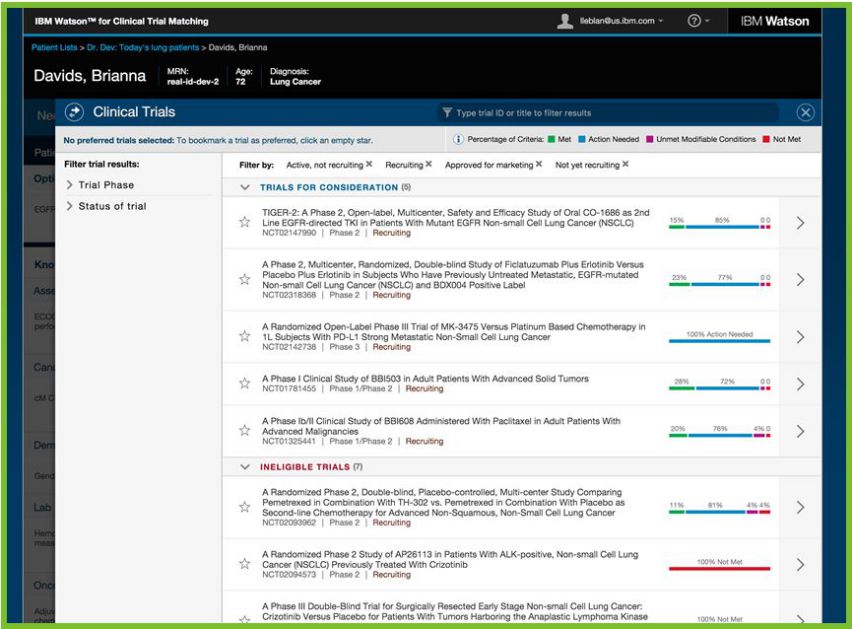IBM Watson Health is putting data to work for all of us to define new paths to better health.
It was almost five years ago that IBM Watson captured the attention of both techies and non-techies alike when it competed and won against human contestants on the Jeopardy! TV game show. The ability for a computer system to quickly understand and answer trivia questions in natural language was impressive, but the immediate question was: how will this technology be applied to industries that are being inundated with information?
The field of medicine—with a plethora of patient and research data—has emerged as a strong fit for Watson's cognitive computing abilities. Not only does a ton of data already exist today, but it continues to grow. Medical literature doubles about every two years, with around 700,000 new scientific articles being published every year. With this rate of information overload, medical professionals need new technologies to help them identify and leverage the latest discoveries in their daily work.
To advance the opportunity to apply cognitive computing to these challenges, the IBM Watson Health business unit was launched in 2015 to bring increased focus on the delivery of cognitive solutions to assist healthcare and life science professionals. Watson Health aims to improve the ability of clinicians, researchers, payers, employers, and other healthcare stakeholders to innovate by surfacing new insights from the massive amount of personal health data being created daily.
At the same time IBM launched the Watson Health business unit, the company also unveiled the Watson Health Cloud platform, which will allow various types and sources of health information to be de-identified, shared, and combined with a dynamic and constantly growing aggregated view of clinical, research, and social health data. IBM and its vast ecosystem of clients, partners, and medical researchers can surface new connections between these diverse and previously siloed healthcare data sets. This valuable data resource will spur the creation of a new generation of data-driven applications and cognitive solutions designed to advance health and wellness.
Watson has a strong foundation in healthcare—an industry that has been an early proponent of the transformative potential of cognitive computing. Watson is helping transform how healthcare is taught, practiced, and researched, with solutions designed to enhance the quality and speed of care delivered to patients through individualized, evidence-based medicine. Here's a list and description of the cognitive solutions that are also part of the IBM Watson Health portfolio.
- Watson Discovery Advisor for Life Sciences can accelerate breakthroughs by making connections and drawing relationships between huge data sets from different scientific domains.
- Watson for Oncology helps give oncologists the data-driven assistance they need to make more-informed treatment decisions. Watson for Oncology analyzes a patient's medical information against a vast array of data and expertise to provide evidence-based treatment options.
- Watson for Clinical Trial Matching (CTM) uses the cognitive computing power of Watson to enhance clinicians' ability to more easily find clinical trials for which a patient may be eligible.
Watson for CTM Examination
My focus at IBM is Watson for CTM, so I've included a few more details on this solution to give you a glimpse at how the cognitive computing power of Watson can be used to address some of the challenges in the clinical trial space. The cost and time involved in clinical trial matching is considerable. More than $1 billion is spent on patient recruitment by drug developers each year, yet fewer than 5% of cancer patients participate in a clinical trial. It also typically takes 6–12 months to start up a global phase III drug trial and another 12 months to enroll the required number of patients.
For doctors who may be seeking clinical trial opportunities for their patients, the challenge is also rather daunting. Just as the number of cancer therapies has increased over the years, there also has been a significant increase in the number of clinical trials available. Staying current on the available clinical trials is a challenging task for clinicians and oncologists. Even if they're aware of the latest trials, there's the time-consuming task of navigating the dozens of inclusion and exclusion criteria associated with the hundreds of trials to determine if their patient is eligible to participate in any trials.
Let's use the following simple, hypothetical trial for breast cancer patients to see how the cognitive capabilities of Watson for Clinical Trial Matching could be applied in action. This sample trial has only three inclusion criteria (most trials contain a couple dozen on average): the patient must meet the conditions defined in all three criteria in order to participate in this trial.
Inclusion Criteria:
- Patient is ER+ and patient has metastatic breast cancer
- Positive surgical margins
- Absolute neutrophil count >= 1500/L
First, clinical trial information is loaded into Watson for CTM (this is also known as ingestion). The first application of Watson's cognitive capabilities to understand natural language occurs during this ingestion process. Each criterion within a trial is examined to detect the key medical concepts and the logical relationships between those concepts.
With the first criteria, Watson for CTM is able to determine the criteria is really spelling out that a patient must have Estrogen receptor positive breast cancer, which has also been classified as Stage IV breast cancer. Right away, based on this interpretation, it should jump out at you that the solution is doing more than simple text matching. First, the solution's ability to recognize that ER+ is referring to Estrogen receptor positive breast cancer demonstrates that it's been trained to recognize shorthand and abbreviations used by oncologists. Second, the cognitive capability to make inferences is exhibited by the automatic recognition that metastatic breast cancer also refers to Stage IV breast cancer. This ability to make inferences and associations is important because there's a good chance that the doctor's notes for a patient will describe the same condition using slightly different terminology (e.g., "Stage IV breast cancer" versus "metastatic breast cancer").
In addition to natural language processing, the first criterion contains two conditions that require logical reasoning to be applied. A patient can only meet this criterion if both conditions evaluate to true. If a patient has Estrogen receptor positive breast cancer that is only Stage III, then Watson for CTM is able to determine that the patient is not a match for this trial since both conditions were not met.
A similar inference is made for the second criterion to determine that it's referring to patients with "positive margins of resection" with the text "positive surgical margins." This criterion provides a good example to discuss how the cognitive processing is applied during the evaluation of a patient. When a patient is compared against a clinical trial's criteria by Watson for CTM, it examines both the patient's structured values (age, weight, etc.) as well as doctor's notes and reports that are stored in an electronic medical record (EMR) system. Natural-language processing is applied against the notes and medical reports to uncover clinical attributes that are referenced in criteria for a clinical trial. Let's suppose that the notes for a patient being evaluated were the following: The patient's resection margins as well as serosal surface were free of tumor. From this set of notes, Watson would be able to determine that the patient had negative margins of resection by connecting the "free of tumor" phrase with the "resection margins" text.
The last criterion defines the minimum count of a specific blood cell type (neutrophil granulocytes) that's required for a patient to be eligible for the trial. Let's assume that a patient blood test falls short of the specified blood cell count. A clinician would inherently know that the patient's blood cell count is a condition that could increase in the future—possibly with treatment. Watson for CTM would also have been trained to recognize which patient conditions are modifiable, so in this situation the criteria would be evaluated as "Not Met – Modifiable" instead of "Not Met." This special designation makes it clear to the clinician that it may be possible to enhance a patient's eligibility for this trial in the future by prescribing a treatment that helps improve this modifiable condition (absolute neutrophil count). The Estrogen receptor positive breast cancer would be an example of a patient condition that is not modifiable.
Once a patient has been evaluated against all of the trials that have been ingested, Watson for CTM displays the best matches for the patient, ranked by the strength of the match. This is shown in Figure 1. From this interface, the clinical team is able to drill down and see how each trial criteria was evaluated for the current patient. If data such as their absolute neutrophil count was missing for a patient, the clinician can input the value and have Watson for CTM re-evaluate the clinical trials taking into account the new data point for the patient.
Figure 1: Watson for CTM Trial Evaluation Report
Clinical trial matching is just one example of the many ways Watson is beginning to transform health and healthcare. As healthcare and life sciences professionals continue to face a deluge of data in their jobs, cognitive solutions will continue to emerge as an essential tool to address some of their key challenges. IBM Watson Health is eager to help solve these problems by putting data to work for all of us to define new paths to better health.













 Business users want new applications now. Market and regulatory pressures require faster application updates and delivery into production. Your IBM i developers may be approaching retirement, and you see no sure way to fill their positions with experienced developers. In addition, you may be caught between maintaining your existing applications and the uncertainty of moving to something new.
Business users want new applications now. Market and regulatory pressures require faster application updates and delivery into production. Your IBM i developers may be approaching retirement, and you see no sure way to fill their positions with experienced developers. In addition, you may be caught between maintaining your existing applications and the uncertainty of moving to something new. IT managers hoping to find new IBM i talent are discovering that the pool of experienced RPG programmers and operators or administrators with intimate knowledge of the operating system and the applications that run on it is small. This begs the question: How will you manage the platform that supports such a big part of your business? This guide offers strategies and software suggestions to help you plan IT staffing and resources and smooth the transition after your AS/400 talent retires. Read on to learn:
IT managers hoping to find new IBM i talent are discovering that the pool of experienced RPG programmers and operators or administrators with intimate knowledge of the operating system and the applications that run on it is small. This begs the question: How will you manage the platform that supports such a big part of your business? This guide offers strategies and software suggestions to help you plan IT staffing and resources and smooth the transition after your AS/400 talent retires. Read on to learn:
LATEST COMMENTS
MC Press Online